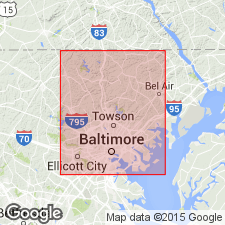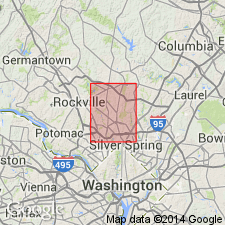
- Usage in publication:
-
- Druid Hill Amphibolite Member
- Modifications:
-
- Named
- Dominant lithology:
-
- Amphibolite
- AAPG geologic province:
-
- Piedmont-Blue Ridge province
Summary:
Named the Druid Hill Amphibolite Member of the James Run Formation for Druid Hill Park, Baltimore City, northeastern MD. Consists of fine- to medium-grained, well-foliated, amphibolite with interlayers of chlorite fels and actinofels. Thickness is 700 m. Overlies or is in thrust contact with Hollofield Layered Ultramafite or Mount Washington Amphibolite of the Baltimore Mafic Complex. Interfingers with Carroll Gneiss Member of James Run Formation. Underlies Relay Gneiss Member of James Run Formation or Jones Falls Schist. Unit is intruded by Cold Spring Gneiss. The Druid Hill is of Cambrian(?) age.
Source: GNU records (USGS DDS-6; Reston GNULEX).

- Usage in publication:
-
- Druid Hill Amphibolite*
- Modifications:
-
- Revised
- AAPG geologic province:
-
- Piedmont-Blue Ridge province
Summary:
Raised the Druid Hill to the Druid Hill Amphibolite. Appears on explanation of generalized geologic map of MD Piedmont (figure 1) as part of the island arc rocks of the Bel Air-Rising Sun and Chopawamsic terranes.
Source: GNU records (USGS DDS-6; Reston GNULEX).
For more information, please contact Nancy Stamm, Geologic Names Committee Secretary.
Asterisk (*) indicates published by U.S. Geological Survey authors.
"No current usage" (†) implies that a name has been abandoned or has fallen into disuse. Former usage and, if known, replacement name given in parentheses ( ).
Slash (/) indicates name conflicts with nomenclatural guidelines (CSN, 1933; ACSN, 1961, 1970; NACSN, 1983, 2005, 2021). May be explained within brackets ([ ]).

